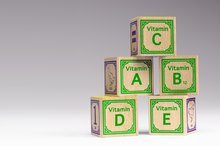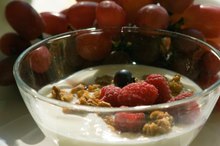Vitamin C Intake for Kids
Whenever you feel that tickle in your throat signaling the start of a cold, the first thing you may do is reach for your vitamin C in hopes that it may help keep you from getting sick.
While you may marvel in the powers of vitamin C for its ability to help you battle your virus, it’s more than an immune booster. The water-soluble nutrient is essential not only for your health, but it's necessary for the normal growth and development of your child.
Your kids need a daily dose of vitamin C to support the formation of muscles and bones, help with the production of energy and create the neurotransmitters that aid in the communication between your child’s nerves and muscles.
How Vitamin C Helps
Whether for boosting the immune system or healing cuts and bruises, meeting the daily vitamin C dosage for kids is very important.
Without enough vitamin C, your child wouldn’t be able to make collagen, which is a supportive protein necessary for the formation of bones, skin, cartilage and connective tissue. Vitamin C is also needed to make neurotransmitters and L-carnitine, which plays a vital role in the production of energy.
Vitamin C also helps protect your child from illnesses by supporting the cells that make up their immune system, and assisting in the creation of the best barrier against foreign invaders: skin.
Your child may not be too worried about heart disease and other chronic illnesses that occur in adulthood, but as an antioxidant, vitamin C may also offer your child some protection against these health issues by fighting off free radicals.
- Whether for boosting the immune system or healing cuts and bruises, meeting the daily vitamin C dosage for kids is very important.
- Vitamin C also helps protect your child from illnesses by supporting the cells that make up their immune system, and assisting in the creation of the best barrier against foreign invaders: skin.
You Can’t Live Without It
What If My Child Ate Too Many Vitamins?
Learn More
The thing about vitamin C is that you and your child can’t live without it.
While most animals are able to manufacture vitamin C, humans cannot, which means it must come from the food you eat. Not getting enough vitamin C can have detrimental effects for your child’s health, growth and development.
Vitamin C is also a water-soluble vitamin, so the body can’t store it for later use, so you need a daily fix to keep the body functioning at its best.
- The thing about vitamin C is that you and your child can’t live without it.
- Vitamin C is also a water-soluble vitamin, so the body can’t store it for later use, so you need a daily fix to keep the body functioning at its best.
Vitamin C Dosage for Kids
The amount of vitamin C your child needs has been determined by the Food and Nutrition Board (FNB) at the Institute of Medicine (IOM) of the National Academies and is based on the recommended dietary allowance (RDA).
The vitamin C dosage for a child is based on age, not gender as in adults:
- The daily requirement of vitamin C for infants 0 to 6 months: 40 milligrams
- The daily requirement of vitamin C for infants 7 to 12 months: 50 milligrams
- The daily requirement of vitamin C for kids 1 to 3 years: 15 milligrams
- The daily requirement of vitamin C for kids 4 to 8 years: 25 milligrams
- The daily requirement of vitamin C for kids 9 to 13 years: 45 milligrams
Tips
The daily requirement of vitamin C for infants is based on the mean intake of the vitamin in healthy breastfed babies.
Once the teenage years hit, your child’s vitamin C needs differ based on gender. Teen girls need 65 milligrams a day, while teen boys need 75 milligrams a day. The recommendations are similar for adults, with men requiring 90 milligrams a day and women 75 milligrams.
Not Enough Vitamin C
The Recommended Multivitamins for a 3 Year Old
Learn More
It’s highly unlikely that your child isn’t getting enough vitamin C. According to the Office of Dietary Supplements (ODS), most kids and teens don’t have a problem meeting the RDA for vitamin C, averaging about 76 milligrams per day.
However, if your child is a picky eater or has a medical condition that affects nutrient absorption, such as Crohn’s or celiac disease, it’s possible she may be missing out on this vital nutrient. Infants fed boiled or evaporated milk, instead of formula or breast milk, are also at risk of vitamin C deficiency.
Signs of a Deficiency
Signs that may indicate a deficiency of vitamin C include:
- Fatigue
- Inflammation of the gums
- Poor wound healing and bruising
- Thick patchy skin
- Changes in mood
Although very rare in developed countries like the United States, a chronic deficiency of vitamin C leads to scurvy, which can be fatal.
Read more: Disadvantages of Vitamin C
Too Much Vitamin C
Vitamin C isn’t toxic at high doses, but you want to be careful about too much vitamin C. It’s not so much a problem with the vitamin C in food, but can be problematic in supplement form. Some vitamin C pills can have as much as 5,000 milligrams per dose.
The FNB has established a tolerable upper limit for vitamin C, which is the maximum amount your child can get per day before experiencing symptoms.
- Tolerable upper limit of vitamin C for infants: not possible to establish
- Tolerable upper limit of vitamin C for children 1 to 3 years: 400 milligrams
- Tolerable upper limit of vitamin C for children 4 to 8 years: 650 milligrams
- Tolerable upper limit of vitamin C for children 9 to 13 years: 1,200 milligrams
- Tolerable upper limit of vitamin C for teens 14 to 18: 1,800 milligrams
- Tolerable upper limit of vitamin C for adults: 2,000 milligrams
Read more: What are the Benefits of Mega Dosing Vitamin C?
- Vitamin C isn’t toxic at high doses, but you want to be careful about too much vitamin C. It’s not so much a problem with the vitamin C in food, but can be problematic in supplement form.
Signs of Vitamin C Toxicity
If your child takes a high-dose vitamin C pill, then she may experience signs and symptoms of vitamin C toxicity, which include:
- Diarrhea
- Nausea
- Abdominal pain
If your child has taken too much vitamin C, contact your pediatrician right away for guidance.
Kid-Friendly Vitamin C Foods
The easiest way to make sure your child is getting an adequate amount of vitamin C is to include plenty of vitamin C-rich foods in their diet. The good news is, vitamin C is found in a wide variety of foods that kids love.
Good foods to meet the vitamin C dosage for kids include:
- 1 medium baked potato: 17 milligrams
- 1 cup of canned tomato sauce:17 milligrams
- 1/2 cup of cooked broccoli: 51 milligrams
- 1 medium orange: 70 milligrams
- 1/2 cup of orange juice: 93 milligrams
- 1/2 cup of sliced red bell peppers: 95 milligrams
Many of these kid-friendly foods provide 100 percent or more of the vitamin C dosage for kids.
Vitamin C Pills
Given that most kids in the U.S. don’t have a difficult time meeting their daily vitamin C needs, it’s highly unlikely that your child would need to supplement. Additionally, you need to be careful about how much you give your child since some vitamin C pills may contain more than your child’s tolerable upper limit.
You may consider giving your child a tasty chewable vitamin C if a cold strikes. However, according to the ODS, vitamin C isn’t likely to do you much good, unless you live in extremely cold temperatures or your child is training for a marathon. That being said, giving your child vitamin C pills may help shorten the length of their cold.
Talk to your child’s pediatrician about vitamin C supplement dosage.
Read more: The Benefits of Vitamin C Tablets
- Given that most kids in the U.S. don’t have a difficult time meeting their daily vitamin C needs, it’s highly unlikely that your child would need to supplement.
- Additionally, you need to be careful about how much you give your child since some vitamin C pills may contain more than your child’s tolerable upper limit.
The Iron Boost
Vitamin C also helps your child absorb more iron. Iron is a mineral that supports the health of red blood cells and transports oxygen throughout the body. Without enough iron, your child may develop iron-deficiency anemia, which can affect their growth and neurological development.
According to the ODS, infants and children are some of the groups most at risk of iron deficiency. Combining iron-rich foods with vitamin C-rich foods may improve your child’s iron absorption to prevent a deficiency and the detrimental effects.
Good food sources of iron include:
- Meat, poultry, pork and seafood
- Beans
- Fortified cereals
- Spinach and broccoli
To help your child get the much-needed boost, try:
- A glass of orange juice with his morning breakfast cereal
- Spaghetti with tomato sauce and meatballs
- Red bell peppers and hummus
- Beef and broccoli stir-fry
- Vitamin C also helps your child absorb more iron.
- According to the ODS with vitamin C-rich foods may improve your child’s iron absorption to prevent a deficiency and the detrimental effects.
Related Articles
References
- University of Queensland: What Are Neurotransmitters?
- National Institutes of Health: Office of Dietary Supplements: Carnitine
- National Institutes of Health: Office of Dietary Supplements: Vitamin C
- MyFoodData: Canned Tomato Sauce
- National Institutes of Health: Office of Dietary Supplements: Iron
- Academy of Nutrition and Dietetics: How Vitamin C Supports a Healthy Immune System
- Nutrients: Vitamin C and Immune Function
- MedlinePlus: Scurvy
- Harvard Health Publishing: By the Way Doctor: What's the Right Amount of Vitamin C for Me?
- Holick MF, Gordon CM. Patient Guide to Vitamin D Deficiency. The Journal of Clinical Endocrinology & Metabolism. 2011;96(7):1-2. doi:10.1210/jcem.96.7.zeg33a
- Sunyecz JA. The use of calcium and vitamin D in the management of osteoporosis. Ther Clin Risk Manag. 2008;4(4):827-836. doi:10.2147/tcrm.s3552
- Giovannucci E, Liu Y, Hollis BW, Rimm EB. 25-hydroxyvitamin D and risk of myocardial infarction in men: a prospective study. Arch Intern Med. 2008;168(11):1174-1180. doi:10.1001/archinte.168.11.1174
- Gorham ED, Garland CF, Garland FC, et al. Optimal vitamin D status for colorectal cancer prevention: a quantitative meta analysis. Am J Prev Med. 2007;32(3):210-216. doi:10.1016/j.amepre.2006.11.004
- Lappe JM, Travers-Gustafson D, Davies KM, Recker RR, Heaney RP. Vitamin D and calcium supplementation reduces cancer risk: results of a randomized trial. The American Journal of Clinical Nutrition. 2007;85(6):1586-1591. doi:10.1093/ajcn/85.6.1586
- Prentice RL, Pettinger MB, Jackson RD, et al. Health risks and benefits from calcium and vitamin D supplementation: Women’s Health Initiative clinical trial and cohort study. Osteoporos Int. 2013;24(2):567-580. doi:10.1007/s00198-012-2224-2
- Urashima M, Segawa T, Okazaki M, Kurihara M, Wada Y, Ida H. Randomized trial of vitamin D supplementation to prevent seasonal influenza A in schoolchildren. Am J Clin Nutr. 2010;91(5):1255-1260. doi:10.3945/ajcn.2009.29094
- Salehpour A, Hosseinpanah F, Shidfar F, et al. A 12-week double-blind randomized clinical trial of vitamin D₃ supplementation on body fat mass in healthy overweight and obese women. Nutr J. 2012;11:78. doi:10.1186/1475-2891-11-78
- Carrillo AE, Flynn MG, Pinkston C, et al. Impact of vitamin D supplementation during a resistance training intervention on body composition, muscle function, and glucose tolerance in overweight and obese adults. Clin Nutr. 2013;32(3):375-381. doi:10.1016/j.clnu.2012.08.014
- Marcinowska-Suchowierska E, Kupisz-Urbańska M, Łukaszkiewicz J, Płudowski P, Jones G. Vitamin D Toxicity-A Clinical Perspective. Front Endocrinol. 2018;9:550. doi:10.3389/fendo.2018.00550
- Ross AC, Manson JE, Abrams SA, et al. The 2011 report on dietary reference intakes for calcium and vitamin D from the Institute of Medicine: what clinicians need to know. J Clin Endocrinol Metab. 2011;96(1):53-58. doi:10.1210/jc.2010-2704
- Bouillon R, Van Schoor NM, Gielen E, et al. Optimal vitamin D status: a critical analysis on the basis of evidence-based medicine. J Clin Endocrinol Metab. 2013;98(8):E1283-E1304. doi:10.1210/jc.2013-1195
- American Academy of Dermatology. Position Statement of Vitamin D. 2010.
- Taksler GB, Cutler DM, Giovannucci E, Keating NL. Vitamin D deficiency in minority populations. Public Health Nutr. 2015;18(3):379-391. doi:10.1017/S1368980014000457
- Holick MF, Binkley NC, Bischoff-Ferrari HA, et al. Evaluation, treatment, and prevention of vitamin D deficiency: an Endocrine Society clinical practice guideline. J Clin Endocrinol Metab. 2011;96(7):1911-1930. doi:10.1210/jc.2011-0385
- Cannell JJ, Vieth R, Umhau JC, et al. Epidemic Influenza and Vitamin D. Epidemiol Infect. 2006; 134:1129-40.
- Carrillo AE1, Flynn MG, Pinkston C, Markofski MM, Jiang Y, Donkin SS, Teegarden D. Impact of Vitamin D Supplementation During a Resistance Training Intervention on Body Composition, Muscle Function, and Glucose Tolerance in Overweight and Obese Adults. Clin Nutr. 2013 Jun;32(3):375-81. doi: 10.1016/j.clnu.2012.08.014. Epub 2012 Aug 31.
- Ginde AA, Mansbach JM, Camargo CA, Jr. Association Between Serum 25-Hydroxyvitamin D Level and Upper Respiratory Tract Infection in the Third National Health and Nutrition Examination Survey. Arch Intern Med. 2009; 169:384-90.
- Giovannucci E, Liu Y, Hollis BW, Rimm EB. 25-hydroxyvitamin D and Risk of Myocardial Infarction in Men: a Prospective Study. Arch Intern Med. 2008; 168:1174-80.
- Gorham ED, Garland CF, Garland FC, Grant WB, Mohr SB, Lipkin M, Newmark HL, Giovannucci E, Wei M, Holick MF. Optimal Vitamin D Status for Colorectal Cancer Prevention: a Quantitative Meta-analysis. Am J Prev Med. 2007 Mar;32(3):210-6.
- Heaney, Robert P. “The Vitamin D Requirement in Health and Disease.” The Journal of Steroid Biochemistry & Molecular Biology 97 (2005):13-9.
- Holick MF. Vitamin D. In: Shils M, Olson J, Shike M, Ross AC, ed. Modern Nutrition in Health and Disease, 9th ed. Baltimore: Williams and Wilkins, 1999.
- National Institutes of Health Office of Dietary Supplements. Vitamin D: Dietary Supplement Fact Sheet. University of Ottawa Evidence-based Practice Center. Effectiveness and Safety of Vitamin D in Relation to Bone Health. Agency for Healthcare Research and Quality. Aug 2007: 07-E013.
- Salehpour A1, Hosseinpanah F, Shidfar F, Vafa M, Razaghi M, Dehghani S, Hoshiarrad A, Gohari M. A 12-week Double-blind Randomized Clinical Trial of Vitamin D₃ Supplementation on Body Fat Mass in Healthy Overweight and Obese Women. Nutr J. 2012 Sep 22;11:78. doi: 10.1186/1475-2891-11-78.
- Urashima M, Segawa T, Okazaki M, Kurihara M, Wada Y, Ida H. Randomized Trial of Vitamin D Supplementation to Prevent Seasonal Influenza A in Schoolchildren. Am J Clin Nutr. 2010 91:1255-60. Epub 2010 Mar 10.
- Wilkins, Consuelo H. and Yvette I. Sheline, et al. “Vitamin D Deficiency Is Associated with Low Mood and Worse Cognitive Performance in Older Adults.” American Journal of Geriatric Psychiatry 14 (2006): 1032-40.
Writer Bio
Jill Corleone is a registered dietitian and health coach who has been writing and lecturing on diet and health for more than 15 years. Her work has been featured on the Huffington Post, Diabetes Self-Management and in the book "Noninvasive Mechanical Ventilation," edited by John R. Bach, M.D. Corleone holds a Bachelor of Science in nutrition.









